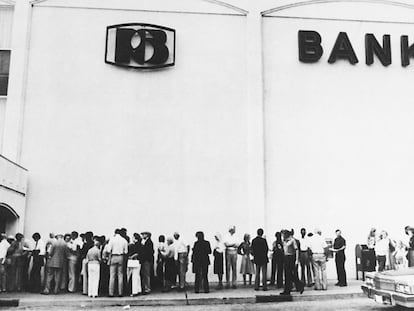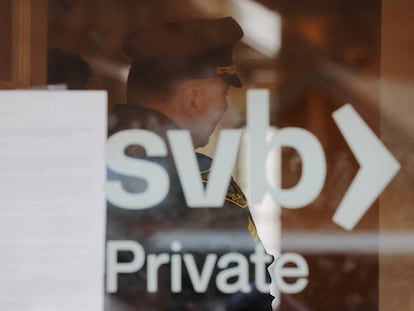Banking panics, social media and history repeating itself
Deposit outflows are the weak flank of U.S. banking, but they are not a technology-driven phenomenon, and it’s far from inevitable

In a few days it will be the one-year anniversary of the collapse of Silicon Valley Bank, probably the fastest collapse of a financial institution in history. On March 8, 2023, the bank announced that it was $1.8 billion in the red when it sold a large part of its public debt portfolio at a loss. At the same time, it announced a capital increase of $2.2 billion to strengthen the bank’s balance sheet, although the loss amounted to barely 1% of the bank’s assets.
Up to that point, Silicon Valley Bank’s stocks and bonds had not been predictors: the stock was trading at $262; it had fallen 20% in a month, but it was above January levels. Senior debt was trading at 96% of par. But the announcement opened a Pandora’s box at breakneck speed.
The next day the stock opened with a 60% drop, and the plunge accelerated the run on deposits. The outflow of money obviously did not slow down; it accelerated. On March 10, the Federal Deposit Insurance Corporation (FDIC) intervened in the bank. By March 13, all deposits were transferred to the FDIC. In just one day, 25% of the liabilities (about $40 billion) had been withdrawn, and the bank had orders to repay 62% the following day.
The fact that a bank went from a normal state to collapse in just 48 hours shattered the financial world, and a theory emerged that the phenomenon was explained by social media. The digital version of word of mouth lit the fuse and mobile money transfer apps did the rest. It was a lazy reading that did not address the lax supervision of the bank. Nor did it match the bank’s profile or even common sense. First, if social media were a predictor or cause of events, banking — and the world in general — would have imploded long ago. And, secondly, when there is fear of a bank collapsing, the priority is knowing whether to withdraw the money and, in any case, making the decision to do so. In this context, airing it out isn’t a priority.
A little over 10 years ago, the biggest known financial risk index came to light: coffee questions. At the height of the euro crisis, the major question among citizens with savings was whether to take their money abroad. The question was more common among, but not exclusive to, the minority of people with over €100,000 in savings, and it was probably asked by some of the readers of this column (I can attest that I heard it on numerous occasions).
One might think that this run on deposits caused the 2012 financial catastrophe in Spain. But this was not the case, or only half of it. According to data from the bank, in 2012 (the year of the bailout) it lost some €23 billion in resident deposits, going from €128.100 billion to €105.635 billion. But concerned individuals didn’t twist the arm of Spanish banks; institutional investors did. The banks shut off the tap on interbank lending and the sector was forced to turn to the European Central Bank (ECB): the Spanish banks’ appeal to the ECB soared to €388 billion in August 2012, five times more than a year earlier. The fall in deposits explains less than a third of the new liquidity needs, considering that, according to the Bank of Spain, the health of liabilities in that year did not reach 100 billion.
That’s not unlike what happened with Silicon Valley Bank. As much as social media appeared assiduously in the comments, the reality is more prosaic. It has a lot to do with a handful of large accounts and little to do with mothers and fathers moving deposits from their cell phones after consulting Twitter. It was a handful of VC funds, crypto-asset and tech firms; around 90% of the bank’s deposits were above the public guarantee ($250,000), with a good number of customers with nine-digit or more accounts.
According to a report from the St. Louis Fed, “Depositors at Silicon Valley Bank reportedly received advice from their venture capital backers to withdraw funds and communicated with each other during the run, drawing on their pre-existing connections to each other.” Other reports have pointed to financial messaging systems as the communication channel through which the panic spread. That’s nothing new under the sun: to think that investors learn the news on equal footing and on public platforms is to not know the market very well. Institutional money always moves first; the opposite would not speak well of the sector’s professionalism. That’s what happened with Silicon Valley, in the euro crisis and in the great financial crisis.
Nor has technology changed that much. As this study recalls, the Continental Illinois bank experienced the first silent collapse in 1984: the bank had been a pioneer in facilitating electronic transactions for all its customers (not just professionals): while the bank’s branches were quiet, the electronic dealing room was in a panic. The bank collapsed in 7 working days.
That is why the measures suggested by the regulators a year after the catastrophe are somewhat traditional. The U.S. Treasury’s Comptroller of the Currency has made several proposals. One is to force banks to operate at least once a year in the Fed’s emergency window, a facility that is stigmatized in the industry; for that reason, banks are reluctant to use it precisely to avoid triggering the panic they want to prevent. Silicon Valley Bank did not even have access to this window.
Forcing banks to have a certain amount of liquidity to meet depositor demands is also on the table, as is keeping enough collateral at the central bank to cover uninsured deposits. The Silicon Valley Bank crisis, the contagion to other regional banks, the fall of Credit Suisse and the market’s focus on New York Community Bank are showing that, at least at present, the liquidity risk of banks seems more difficult to manage than solvency risk.
The ECB has (rightly) insisted that supervisory criteria are more robust in the eurozone (the banking authority supervises liquidity coverage, funding sources and interest rate risk). The deterioration of capital, the inability to absorb losses, was a war that the financial sector had to fight at times of real estate hangover, and one that it might have to face in the future. Today the battle is elsewhere, but it is by no means a new one.
Sign up for our weekly newsletter to get more English-language news coverage from EL PAÍS USA Edition
Tu suscripción se está usando en otro dispositivo
¿Quieres añadir otro usuario a tu suscripción?
Si continúas leyendo en este dispositivo, no se podrá leer en el otro.
FlechaTu suscripción se está usando en otro dispositivo y solo puedes acceder a EL PAÍS desde un dispositivo a la vez.
Si quieres compartir tu cuenta, cambia tu suscripción a la modalidad Premium, así podrás añadir otro usuario. Cada uno accederá con su propia cuenta de email, lo que os permitirá personalizar vuestra experiencia en EL PAÍS.
¿Tienes una suscripción de empresa? Accede aquí para contratar más cuentas.
En el caso de no saber quién está usando tu cuenta, te recomendamos cambiar tu contraseña aquí.
Si decides continuar compartiendo tu cuenta, este mensaje se mostrará en tu dispositivo y en el de la otra persona que está usando tu cuenta de forma indefinida, afectando a tu experiencia de lectura. Puedes consultar aquí los términos y condiciones de la suscripción digital.
More information
Archived In
Últimas noticias
Most viewed
- Reinhard Genzel, Nobel laureate in physics: ‘One-minute videos will never give you the truth’
- Oona Chaplin: ‘I told James Cameron that I was living in a treehouse and starting a permaculture project with a friend’
- Pablo Escobar’s hippos: A serious environmental problem, 40 years on
- Why we lost the habit of sleeping in two segments and how that changed our sense of time
- Charles Dubouloz, mountaineering star, retires at 36 with a farewell tour inspired by Walter Bonatti











































